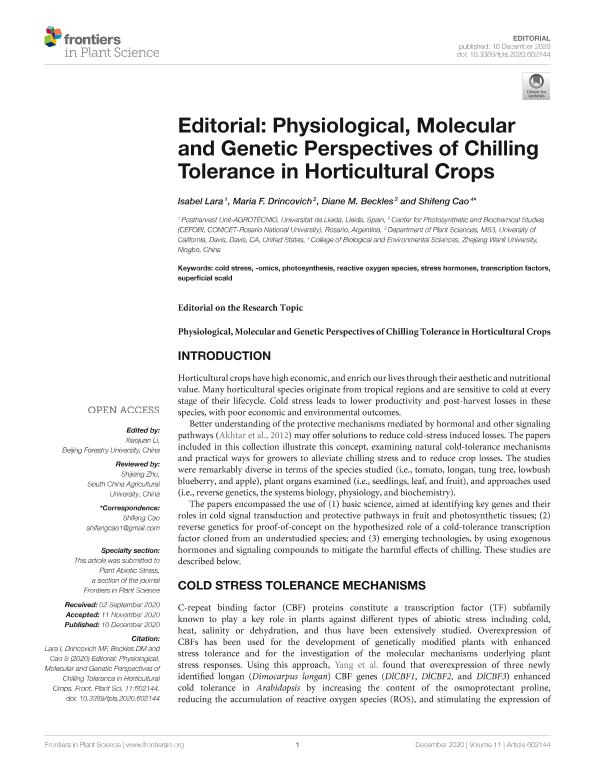Mostrar el registro sencillo del ítem
dc.contributor.author
Lara, Isabel
dc.contributor.author
Drincovich, Maria Fabiana

dc.contributor.author
Beckles, Diane M.
dc.contributor.author
Cao, Shifeng
dc.date.available
2022-10-17T14:26:31Z
dc.date.issued
2020-12
dc.identifier.citation
Lara, Isabel; Drincovich, Maria Fabiana; Beckles, Diane M.; Cao, Shifeng; Editorial: physiological, molecular and genetic perspectives of chilling tolerance in horticultural crops; Frontiers Media; Frontiers in Plant Science; 11; 12-2020; 1-3
dc.identifier.uri
http://hdl.handle.net/11336/173482
dc.description.abstract
Horticultural crops have high economic, and enrich our lives through their aesthetic and nutritional value. Many horticultural species originate from tropical regions and are sensitive to cold at every stage of their lifecycle. Cold stress leads to lower productivity and post-harvest losses in these species, with poor economic and environmental outcomes. Better understanding of the protective mechanisms mediated by hormonal and other signaling pathways (Akhtar et al., 2012) may offer solutions to reduce cold-stress induced losses. The papers included in this collection illustrate this concept, examining natural cold-tolerance mechanisms and practical ways for growers to alleviate chilling stress and to reduce crop losses. The studies were remarkably diverse in terms of the species studied (i.e., tomato, longan, tung tree, lowbush blueberry, and apple), plant organs examined (i.e., seedlings, leaf, and fruit), and approaches used (i.e., reverse genetics, the systems biology, physiology, and biochemistry). The papers encompassed the use of (1) basic science, aimed at identifying key genes and their roles in cold signal transduction and protective pathways in fruit and photosynthetic tissues; (2) reverse genetics for proof-of-concept on the hypothesized role of a cold-tolerance transcription factor cloned from an understudied species; and (3) emerging technologies, by using exogenous hormones and signaling compounds to mitigate the harmful effects of chilling. These studies are described below
dc.format
application/pdf
dc.language.iso
eng
dc.publisher
Frontiers Media

dc.rights
info:eu-repo/semantics/openAccess
dc.rights.uri
https://creativecommons.org/licenses/by/2.5/ar/
dc.subject
-OMICS
dc.subject
COLD STRESS
dc.subject
PHOTOSYNTHESIS
dc.subject
REACTIVE OXYGEN SPECIES
dc.subject
STRESS HORMONES
dc.subject
SUPERFICIAL SCALD
dc.subject
TRANSCRIPTION FACTORS
dc.subject.classification
Bioquímica y Biología Molecular

dc.subject.classification
Ciencias Biológicas

dc.subject.classification
CIENCIAS NATURALES Y EXACTAS

dc.title
Editorial: physiological, molecular and genetic perspectives of chilling tolerance in horticultural crops
dc.type
info:eu-repo/semantics/article
dc.type
info:ar-repo/semantics/artículo
dc.type
info:eu-repo/semantics/publishedVersion
dc.date.updated
2021-09-06T20:58:27Z
dc.identifier.eissn
1664-462X
dc.journal.volume
11
dc.journal.pagination
1-3
dc.journal.pais
Suiza

dc.journal.ciudad
Lausana
dc.description.fil
Fil: Lara, Isabel. Universidad de Lleida; España
dc.description.fil
Fil: Drincovich, Maria Fabiana. Consejo Nacional de Investigaciones Científicas y Técnicas. Centro Científico Tecnológico Conicet - Rosario. Centro de Estudios Fotosintéticos y Bioquímicos. Universidad Nacional de Rosario. Facultad de Ciencias Bioquímicas y Farmacéuticas. Centro de Estudios Fotosintéticos y Bioquímicos; Argentina
dc.description.fil
Fil: Beckles, Diane M.. University of California at Davis; Estados Unidos
dc.description.fil
Fil: Cao, Shifeng. Zhejiang Wanli University; China
dc.journal.title
Frontiers in Plant Science
dc.relation.alternativeid
info:eu-repo/semantics/altIdentifier/url/https://www.frontiersin.org/articles/10.3389/fpls.2020.602144/full
dc.relation.alternativeid
info:eu-repo/semantics/altIdentifier/doi/http://dx.doi.org/10.3389/fpls.2020.602144
Archivos asociados
